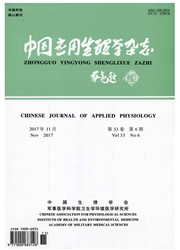

 中文摘要:
中文摘要:
目的:以类风湿性关节炎(RA)的小鼠模型—胶原诱导性关节炎(CIA)为研究对象,探讨在CIA发病过程中淋巴组织的CD4+T细胞表达儿茶酚胺合成的限速酶—酪氨酸羟化酶(TH)的变化,为淋巴细胞的内源性儿茶酚胺参与自身免疫性疾病的发病机制提供研究基础。方法:在DBA/1小鼠尾根部皮内多点注射鸡Ⅱ型胶原乳剂以诱导CIA,在初次免疫后的第22天开始进行小鼠的关节临床评分,并在初次免疫后的第35和第55天进行小鼠踝关节的组织病理学观察。用免疫荧光组织化学法检测小鼠在初次免疫后的第35和55天,其肠系膜淋巴结和脾脏中的TH阳性细胞数和CD4阳性细胞数的变化,以及TH+和CD4+T细胞共定位的细胞数量变化。结果:在初次免疫后的第29~32天,小鼠出现关节红肿,临床评分升高,在第46天达到高峰。踝关节病理学检查发现,CIA小鼠在发病早期(初次免疫后第35天)和发病晚期(初次免疫后第55天)其关节滑膜组织中炎性细胞浸润、滑膜组织增生、关节间隙变窄、部分关节软骨破坏。与正常组和佐剂对照组相比,CIA小鼠在发病早期和发病晚期其肠系膜淋巴结和脾脏中的TH+细胞数目和CD4+T细胞数目均显著增多,而且TH+和CD4+共定位的细胞数目也明显增多,但在CIA小鼠的发病早期与发病晚期之间,这些阳性细胞的数目无统计学差异。结论:在CIA发病过程中,CD4+T细胞表达TH增加,提示淋巴细胞的内源性儿茶酚胺参与RA的发病机制。
 英文摘要:
英文摘要:
Objective: To show the involvement of lymphocyte-derived catecholamines in the pathogenesis of rheumatoid arthritis(RA),we investigated the change in expression of tyrosine hydroxylase(TH),a rate-limiting enzyme of catecholamine synthesis,by CD4+ T lymphocytes in lymphoid tissues of DBA/1 mice with collagen-induced arthritis(CIA).Methods: CIA model was induced by chicken type Ⅱ collagen in DBA/1 mice.The joints of the mice were observed for clinical score of swelling on and after the 22nd day of primary immunization.Pathological changes of ankles were examined by staining of tissue sections with hematoxylin and eosin on the 35th and 55th day following primary immunization.Immunofluorescent histochemistry was used to identify the number of TH-positive,CD4-postive, and double-labeled cells in the mesenteric lymph nodes and the spleen.Results: Paw-swelling onset was on days 29~32 after the first immunization in DBA/1 mice.Clinical score for swelling of the paws reached peak on day 46 after the first immunization.Compared with the ankles of intact or vehicle mice,the joints of CIA mice had these characteristics: increased inflammatory cells in the synovial tissues,proliferated synoviocytes in the multilayers,narrowed articular space,and destructed articular cartilages.Simultaneously,the number of TH-positive,CD4-postive,and double-labeled cells in the mesenteric lymph nodes and the spleen was significantly increased on days 35 and 55 following the first immunization.Between day 35 and day 55 post-immunization,there was no significant difference in the number of these positive cells.Conclusion: CD4+ T lymphocytes up-regulate TH expression in the process of CIA and therefore,it is suggested that endogenous catecholamines of lymphocytes involve in the pathogenesis of RA.
 同期刊论文项目
同期刊论文项目
 同项目期刊论文
同项目期刊论文
 期刊信息
期刊信息
